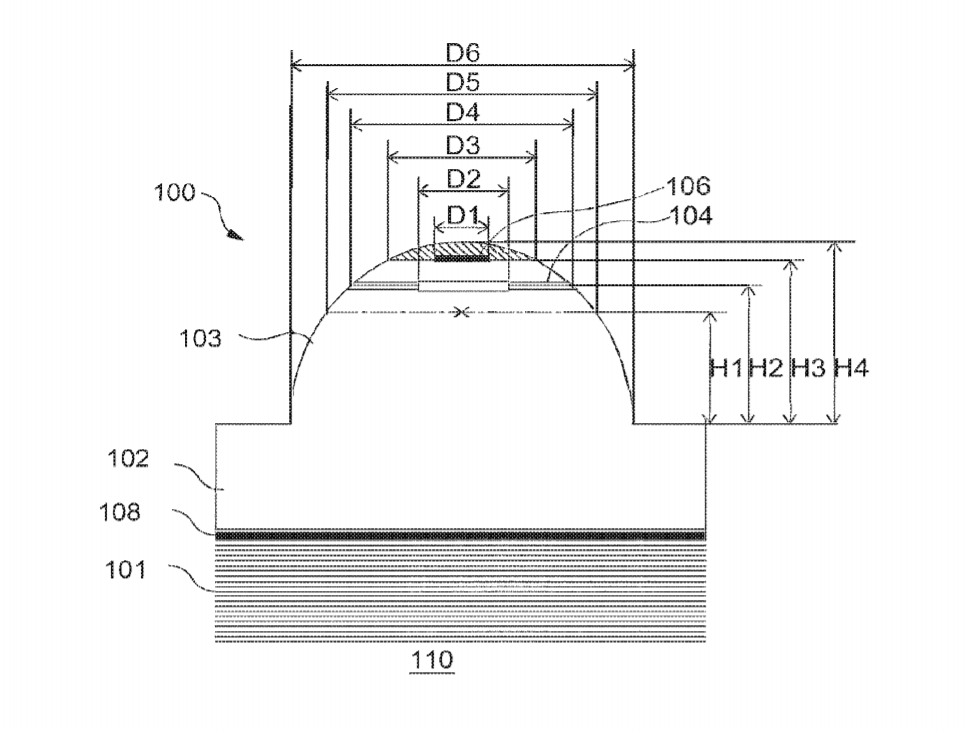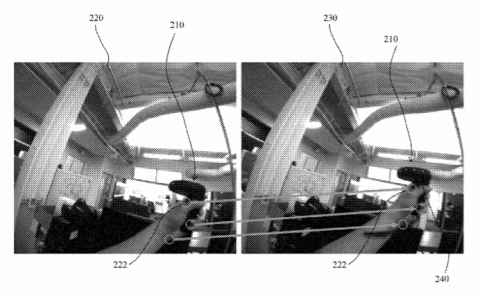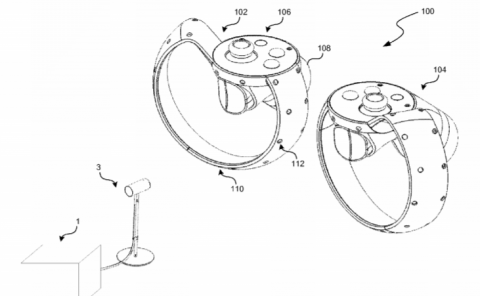Oculus Patent | Micro-led device
Patent: Micro-led device
Publication Number: 20190013438
Publication Date: 2019-01-10
Applicants: Oculus

Abstract
A micro-LED, .mu.LED, comprising: a substantially parabolic mesa structure; a light emitting source within the mesa structure; and a primary emission surface on a side of the device opposed to a top of the mesa structure; wherein the mesa structure has an aspect ratio, defined by (H2*H2)/Ac, of less than 0.5, and the .mu.LED further comprises a reflective surface located in a region from the light emitting source to the primary emission surface, wherein the reflective surface has a roughness, Ra, less than 500 nm.
Background
When compared to standard LED devices, .mu.LEDs may provide advantages of increased extraction efficiency (EE) and a “quasi-collimated” light output, that is, a light output that is at least partially directional. These advantages may be achieved by the introduction of a parabolic mesa structure to the .mu.LED, in which an active layer or light emitting layer sits. Light that is emitted from the light emitting layer is reflected from the internal surface of the mesa and out of the .mu.LED from an emission surface opposed to the mesa. Such a .mu.LED is shown in U.S. Pat. No. 7,518,149.
There is a need for improvements to the .mu.LEDs comprising a mesa structure to provide improved collimation of light.
Summary
According to the invention in a first aspect, there is provided a micro-LED, .mu.LED, comprising: a substantially parabolic mesa structure; a light emitting source within the mesa structure; and a primary emission surface on a side of the device opposed to a top of the mesa structure; wherein the mesa structure has an aspect ratio, defined by (H2*H2)/Ac, of less than 0.5, and the .mu.LED further comprises a reflective surface located in a region from the light emitting source to the primary emission surface, wherein the reflective surface has a roughness, Ra, less than 500 nm.
Reflective surface as used herein encompasses a surface of a .mu.LED to air, but more broadly, may also encompass an interface between two mediums. For example, a reflective surface may be a surface of a .mu.LED between an emitting medium and another medium. The light may be partially or fully reflected depending on its incidence angle.
The primary emission surface is the surface of the .mu.LED from which the majority of light is emitted. Typically, the primary emission surface may be a surface of an epilayer. The primary emission surface may be polished to achieve the desired surface roughness. In embodiments in which the epilayer abuts a substrate of a different material one or both of the primary emission surface and a surface of the substrate may have a surface roughness, Ra, less than 500 nm. Further, one or both of the primary emission surface and a surface of the substrate may be polished to achieve the desired surface roughness.
As shown below, the low aspect ratio is counterintuitive to the disclosure of the art, as is the low roughness of the reflective surface. The combination of these features allows parasitic rays emitted from the emission source to be internally reflected, thereby reducing the half angle (and increasing the collimation) of the .mu.LED.
Previous .mu.LEDs select a high aspect ratio and/or a rough or shaped reflective and/or emission surface to enhance the extraction efficiency. In exemplary .mu.LEDs disclosed herein, a low roughness reflective surface and a low aspect ratio near-parabolic mesa are combined. These two parameters taken separately decrease the extraction efficiency, but it is demonstrated herein that, when combined, they provide a surprising effect of the enhancement of the light collimation.
Optionally, the reflective surface is the primary emission surface.
Optionally, the reflective surface has a roughness, Ra, of less than 300 nm.
Optionally, the reflective surface is an interface between a first material having a first refractive index and a second material having a second refractive index.
Optionally, the first material comprises an epilayer and the second material comprises a substrate upon which the .mu.LED is fabricated.
Optionally, the .mu.LED is formed from GaN on a sapphire substrate, and wherein the interface between two materials is the interface between the GaN and the sapphire substrate.
Optionally, the reflective surface has a roughness, Ra, less than 500 nm (and, in exemplary apparatus, less than 300 nm) in a region greater than or equal to a cross sectional area of a base of the mesa, and aligned with a central axis of the mesa. The region may be in a range from substantially equal to the cross sectional area of the base of the mesa to 1.5 times the cross sectional area of the base of the mesa.
Optionally, the aspect ratio of the mesa structure is less than 0.3.
Optionally, the mesa structure comprises a truncated top.
Optionally, the light emitting source is offset from a central axis of the mesa structure.
Optionally, the light emitting source is offset by a distance on one or both of perpendicular axes lying in a plane parallel to the primary emission surface.
Optionally, the offset distance in each of the perpendicular axes is in a range from 1 .mu.m to 5 .mu.m.
Optionally, the offset distance in each of the perpendicular axes is in a range from 10% to 50% of the total distance from the central axis to an edge of the mesa in each of the perpendicular axes.
Optionally, the light emitting source is configured to emit light anisotropically, such that the light is emitted from the light emitting source substantially in a direction perpendicular to the direction of emission of light from the .mu.LED.
Optionally, the emission of light from the light emitting source is controlled using index guiding and/or dipole anisotropy.
Optionally, the .mu.LED further comprises an additive layer applied to the primary emission surface, wherein the additive layer attenuates light incident thereon at a given angle and/or at above a given wavelength.
Optionally, the additive layer is a multi-level dielectric filter.
Optionally, the source occupancy of the light emitting source within a light emitting layer of the mesa structure is in a range from 20% to 50%.
According to the invention in a second aspect, there is provided a micro-LED, .mu.LED, comprising: a substantially parabolic mesa structure; a light emitting source within the mesa structure; and a primary emission surface on a side of the device opposed to a top of the mesa structure; wherein the mesa structure has an aspect ratio defined by (H2*H2)/Ac less than 0.3.
According to the invention in a third aspect, there is provided a micro-LED, .mu.LED, comprising: a substantially parabolic mesa structure; a light emitting source within the mesa structure; and a primary emission surface on a side of the device opposed to a top of the mesa structure; wherein the light emitting source is offset from a central axis of the mesa structure.
According to the invention in a fourth aspect, there is provided a micro-LED, .mu.LED, comprising: a substantially parabolic mesa structure; a light emitting source within the mesa structure; and a primary emission surface on a side of the device opposed to a top of the mesa structure; wherein the light emitting source is configured to emit light anisotropically, such that light is emitted from the light emitting source substantially in a direction perpendicular to the direction of emission of light from the .mu.LED.
According to the invention in a fifth aspect, there is provided a micro-LED, .mu.LED, cluster comprising a plurality of .mu.LEDs according to any described above and formed on a common substrate.
According to the invention in a sixth aspect, there is provided a display device comprising a plurality of .mu.LEDs according to any described above.
According to a further aspect of the invention, there is provided a micro-LED, .mu.LED, comprising: a substantially parabolic mesa structure; a light emitting source within the mesa structure; and a primary emission surface on a side of the device opposed to a top of the mesa structure; wherein light emitted from the light emitting source is anisotropic.
The anisotropic nature of the light emitted from the light emitting source may be in a direction substantially parallel to the primary emission surface, substantially perpendicular to a primary direction of emission of the .mu.LED or substantially in a plane of the light emitting source. The light emitted by the light emitting source may be guided and/or encouraged within the mesa structure in a direction substantially parallel to the primary emission surface, substantially perpendicular to a primary direction of emission of the .mu.LED or substantially in a plane of the light emitting source.
The light emitting source may be substantially planar. Further, the primary direction of emission of the .mu.LED may be taken as a direction from a centre of the light emitting source and normal to the primary emission surface.
The light emitting source may be configured to emit light weighted towards a direction substantially parallel to the primary emission surface, substantially perpendicular to a primary direction of emission of the .mu.LED or substantially in a plane of the light emitting source. The weighting may result in at least 50% of the emitted light being emitted in a range from 30 degrees, 25 degrees, 20 degrees, 15 degrees or 10 degrees either side of a direction substantially parallel to the primary emission surface, substantially perpendicular to a primary direction of emission of the .mu.LED or substantially in a plane of the light emitting source.
The weighting may result in at least 40%, 50%, 60% or 70% of the emitted light being directly incident on an internal sidewall of the mesa structure.
The anisotropic light emitting source may form part of the guiding or may aid the guiding. That is, the guiding may be provided, at least in part, by the anisotropic emission of light from the light emitting source, or the guiding may be provided by configuration of a material within the mesa and aided by the anisotropic emission of light from the light emitting source.



